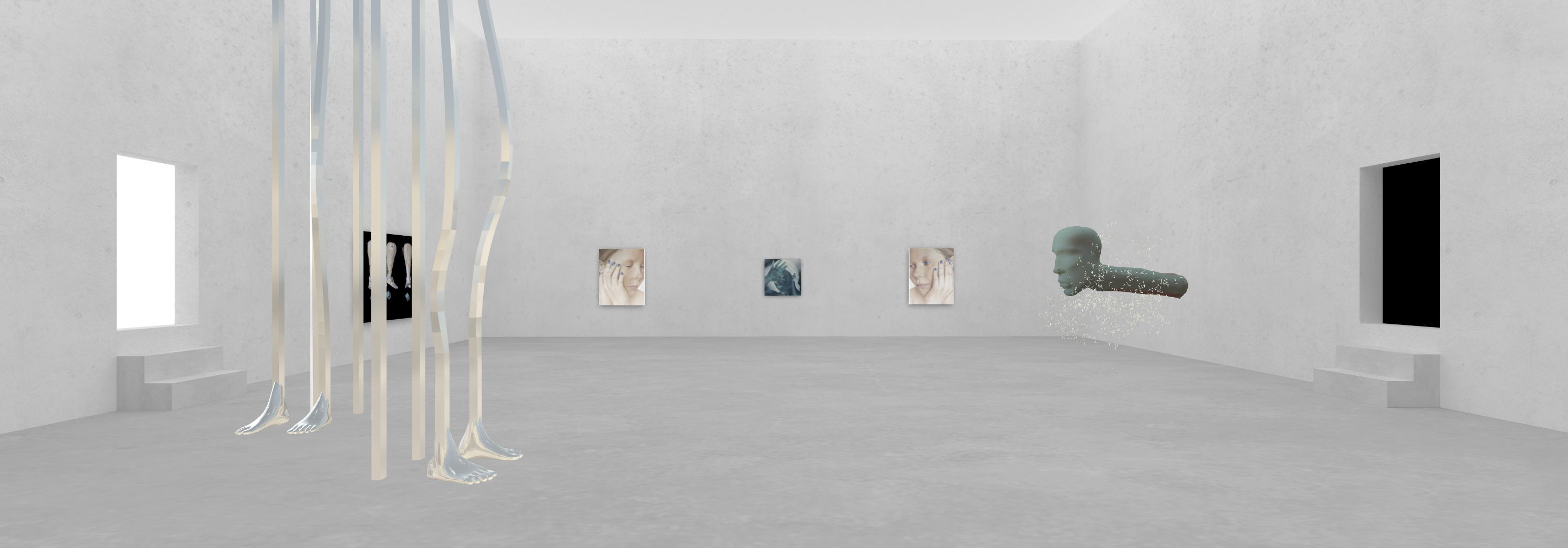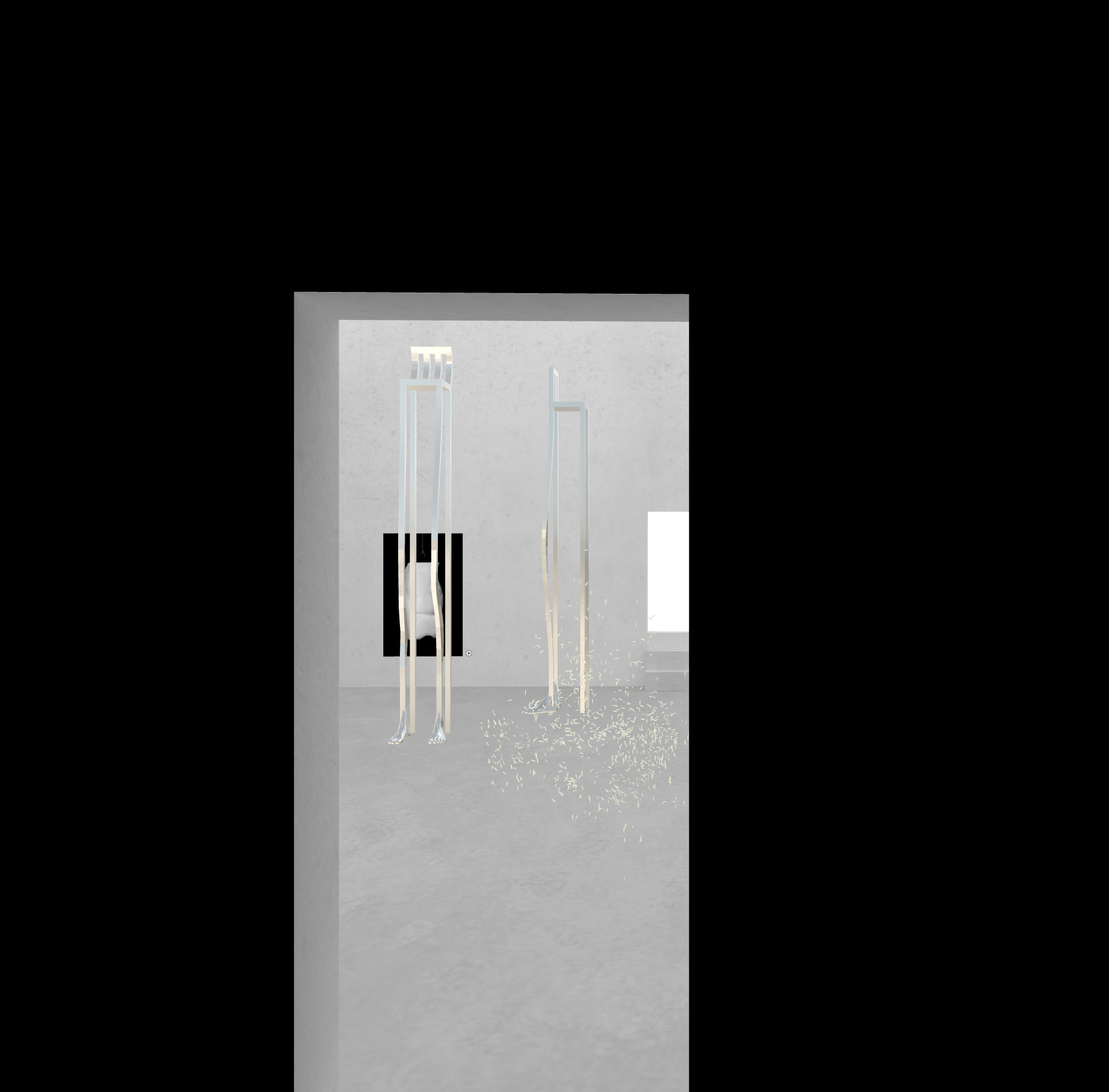
13 May 2022 - 13 July 2022
We are proud to present the very first GREY STATE exhibition featuring ⅔ of our co-founders—Masha Morgunova and Sulay Ranjit—who have a history of collaboration in various forms of expression, including photography, painting, and video.
semblance explores broader themes of identity and perception. Although manifested through different media and styles, each work in this exhibition attempts to interpret and depict a relationship between reality and its reflection(s). We hope this exhibition offers some insight and clarity into Masha's and Sulay's respective art practices.
Masha’s recent work investigates the German term Weltschmerz (world-pain) that describes a feeling of melancholia associated with the weariness of the world. She currently explores this topic through figurative paintings using inversion of color, which allows her to create a contemplative, desolate, and uncanny simulacrum of reality with which we are familiar. Sulay’s recent works, often taking sculptural form, probe the notion of a fragmented consciousness; he imagines immaterial fragments coming into material being as whole objects/experiences.
semblance explores broader themes of identity and perception. Although manifested through different media and styles, each work in this exhibition attempts to interpret and depict a relationship between reality and its reflection(s). We hope this exhibition offers some insight and clarity into Masha's and Sulay's respective art practices.
Masha’s recent work investigates the German term Weltschmerz (world-pain) that describes a feeling of melancholia associated with the weariness of the world. She currently explores this topic through figurative paintings using inversion of color, which allows her to create a contemplative, desolate, and uncanny simulacrum of reality with which we are familiar. Sulay’s recent works, often taking sculptural form, probe the notion of a fragmented consciousness; he imagines immaterial fragments coming into material being as whole objects/experiences.


“ We came to form a close personal and artistic friendship while sharing a studio space as college students. Over the years, we have seen each other's practice evolve, both independently and collaboratively. The works assembled within this exhibition may seem vastly different, but they share a deeply rooted interest in human experience. Today, although physically separated by over twelve thousand kilometers, we are excited to virtually come together in semblance. ”
Waiting for the Summer Rain
This series contains inversion paintings, meaning that the colors in them are flipped to their opposites to create an uncanny version of the world with which we are familiar. Inversion here serves as a symbol of a deep inner imbalance caused by an amplified Weltschmerz (World-pain)—a German term that describes a feeling of melancholia associated with the weariness of the world and it’s apparent distance from the idyll. With pressing environmental, political, and social issues, as well as incessant contact with media, I believe that such melancholic apathy is a relevant phenomenon in a contemporary cataclysmic world. In Waiting for the Summer Rain, I am compelled to explore how being exposed to the pain of our world—whether past (e.g. historical atrocities), present (e.g. ongoing wars and conflicts), or future (e.g. climate crisis)—can affect individuals and shape our collective state of being.
The painted figures, radiating blue light, are shown in contemplative positions, each preoccupied with their own quiet internal turmoil. Deriving inspiration from William Gass’ and Maggie Nelson’s written meditations on blue, I am determined that this color embodies the desired connotations to portray a contemporary Weltschmerz - solitude and contemplation, grief and longing, emergence of life and its fading.
Masha Morgunova
Sulay Ranjit
fragment(s)
What is it to experience an amalgamation of immaterial fragments that have endured, transcending histories and permeating the fabric of present space and time? Through my works included in this exhibition, I probe the notion of a fragmented consciousness and how it is experienced as a seamless singular in the present.
A number of sculptural works in this series come to form as physically whole objects through the fusion of disparate elements. This body of work represents my recent attempts at creating a kind of language that forces the audience to view fused fragments, so as to form conceptual links between the fragments as relational and formative towards a supposed whole. Disjoint body parts then become a commonly accessible motif — I explore anthropomorphic tendencies for their immediacy in terms of generating senses of memory, and of conveying immateriality through material forms. My non-sculptural works exhibit similar ideas as well.
In particular, I Smell Like Curry points to an instance of a fragmented self and the affective dimension that it inhabits as a brown body moves through euro-american spaces in an allegedly post-colonial world. Liminal experiences of the self are intriguing, and I believe that their study is pertinent to more inclusive and robust interrogations of identities, social dynamics, and structures of power embedded therein.
In the end, I want to let my works continually generate their own meanings, both for the viewers and for myself. Some of these works were conceived as early as 2020, and continue to be adapted for virtual display environments in response to physical, material, and spatial limitations.
What is it to experience an amalgamation of immaterial fragments that have endured, transcending histories and permeating the fabric of present space and time? Through my works included in this exhibition, I probe the notion of a fragmented consciousness and how it is experienced as a seamless singular in the present.
A number of sculptural works in this series come to form as physically whole objects through the fusion of disparate elements. This body of work represents my recent attempts at creating a kind of language that forces the audience to view fused fragments, so as to form conceptual links between the fragments as relational and formative towards a supposed whole. Disjoint body parts then become a commonly accessible motif — I explore anthropomorphic tendencies for their immediacy in terms of generating senses of memory, and of conveying immateriality through material forms. My non-sculptural works exhibit similar ideas as well.
In particular, I Smell Like Curry points to an instance of a fragmented self and the affective dimension that it inhabits as a brown body moves through euro-american spaces in an allegedly post-colonial world. Liminal experiences of the self are intriguing, and I believe that their study is pertinent to more inclusive and robust interrogations of identities, social dynamics, and structures of power embedded therein.
In the end, I want to let my works continually generate their own meanings, both for the viewers and for myself. Some of these works were conceived as early as 2020, and continue to be adapted for virtual display environments in response to physical, material, and spatial limitations.


